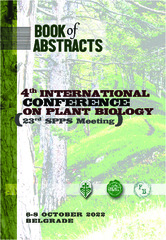| dc.creator | Stojanov, Nadežda | |
| dc.creator | Đukanović, Nina | |
| dc.creator | Zeremski, Tijana | |
| dc.creator | Maletić, Snežana | |
| dc.creator | Marjanović-Jeromela, Ana | |
| dc.date.accessioned | 2022-10-04T10:38:02Z | |
| dc.date.available | 2022-10-04T10:38:02Z | |
| dc.date.issued | 2022 | |
| dc.identifier.isbn | 978-86-912591-6-7 | |
| dc.identifier.uri | http://fiver.ifvcns.rs/handle/123456789/3105 | |
| dc.description.abstract | Industrialization and human activities have resulted in the release of various contaminants into the aquatic ecosystem. As a result of the discharge of untreated wastewater, heavy metals are often present in the sediment. Phytoremediation is the environmentally friendly process of using plants and their associated microbes for environmental cleanup due to their intensive uptake of contaminants. To assess the phytoremediation ability of different species of energy plant, pot tests were conducted. The heavy metal contaminated sediment from Begej Canal was used. Pot experiments were performed in the open field under natural weather conditions, in pots filled with 20 kg of sediment. Plants selected for pot trials were rapeseed (Brassica napus), white mustard (Brassica alba), hemp (Cannabis sativa), and sunflower (Helianthus annuus). Pots with rapeseed were treated with commercial products for plant growth-promoting rhizobacteria, PGPR (TrifenderPro, PanoramaBio, and BioEho). Ten weeks after sowing, harvest was performed, and the below- and above-ground biomasses were measured. The contaminated sediment did not affect plant growth and obtained biomass. Among rape-seed trials, the highest biomass was obtained in the treatment with PGPR TrifenderPro. The plant samples were digested, and the content of Pb, Cr, and Cu was analyzed. Bioaccumulation (BAF) and translocation factors (TF) were calculated. In the case of Cr, the highest BAF was obtained for rapeseed with no treatment and with TrifenderPro treatment, and hemp. In the case of Cu the highest BAF was obtained for sunflower. TF was <1, which indicates that the main mechanism of metal removal is phytostabilization, not phytoextraction. | sr |
| dc.language.iso | en | sr |
| dc.publisher | Belgrade : Serbian Plant Physiology Society | sr |
| dc.publisher | Belgrade : University of Belgrade, Institute for Biological Research „Siniša Stanković“ | sr |
| dc.publisher | Belgrade : University of Belgrade, Faculty of Biology | sr |
| dc.relation | info:eu-repo/grantAgreement/EC/H2020/101006912/EU// | sr |
| dc.rights | openAccess | sr |
| dc.rights.uri | https://creativecommons.org/licenses/by/4.0/ | |
| dc.source | Book of Abstracts, 4th International Conference on Plant Biology (23rd SPPS Meeting), 6-8 October 2022, Belgrade | sr |
| dc.subject | energy crops | sr |
| dc.subject | heavy metals | sr |
| dc.subject | phytoextraction | sr |
| dc.subject | sediment | sr |
| dc.title | The possibility of energy plants for phytoremediation of heavy metal contaminated sediment | sr |
| dc.type | conferenceObject | sr |
| dc.rights.license | BY | sr |
| dc.citation.epage | 102 | |
| dc.citation.spage | 102 | |
| dc.identifier.fulltext | http://fiver.ifvcns.rs/bitstream/id/8706/Stojanov.pdf | |
| dc.identifier.rcub | https://hdl.handle.net/21.15107/rcub_fiver_3105 | |
| dc.type.version | publishedVersion | sr |


